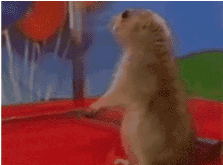
Posted on 12/15/2017 2:27:16 PM PST by Red Badger

The crest-tailed mulgara was once widely distributed across sandy deserts in inland Australia. Credit: Reece Pedler
=====================================================================================
A crest-tailed mulgara, a small carnivorous marsupial known only from fossilised bone fragments and presumed extinct in NSW for more than century, has been discovered in Sturt National Park north-west of Tibooburra.
A team from the UNSW Sydney's Wild Deserts project made the unexpected discovery during recent scientific monitoring.
UNSW scientist and wild deserts ecologist Dr Rebecca West says it is particularly exciting to find a crest-tailed mulgara alive for the first time in NSW.
"The crest-tailed mulgara was once widely distributed across sandy desert environments in inland Australia, but declined due to the effects of rabbits, cats and foxes," West says.
"The species weighs around 150 grams and has pale blonde fur and a thick tail with a distinctive black crest."
The discovery comes at a great time, according to UNSW scientist and Wild Deserts project coordinator Reece Pedler.
"Next year we are due to begin introduced predator and rabbit eradication from a large area, which will no doubt help the Mulgara," Pedler says.
National Parks and Wildlife Service area manager Jaymie Norris says the Wild Deserts project is contributing to the NSW Government's Saving our Species conservation program (SOS).
"The aim of this project is to return mammal species not seen in their natural habitat for over 90 years in Sturt National Park," he says.

Reduced rabbit populations over the past 20 years are thought to have benefited the species. Credit: Katherine Moseby
======================================================================================
"Rabbits, cats and foxes will be eradicated from two 20-square-kilometre fenced exclosures in Sturt National Park, before locally extinct mammals are reintroduced.
"Reintroduced native mammal species will include greater bilby, burrowing bettong, western quoll and western barred bandicoot."
The Wild Deserts project is a partnership between UNSW and Ecological Horizons, in collaboration with Taronga Conservation Society Australia.
Wild Deserts has been contracted by the NSW Office of Environment and Heritage to restore and promote desert ecosystems in Sturt National Park.
Previous work in South Australia by Wild Deserts team members suggests that the crest-tailed mulgara has been recovering in numbers and expanding its range.
Reduced rabbit populations during the past 20 years due to release of rabbit calicivirus is thought to have benefited the species by leading to increases in ground cover.
Reductions in populations of introduced predators such as cats and foxes has also increased the numbers of small rodents for mulgara to prey on.
In recent years, crest-tailed mulgara have expanded their distribution in the Strzelecki Desert over the border in South Australia.
It’s adorable!!
They should make the into pets.
Ever hear of a gerbil shortage?...................
The headline got me; I was hoping it to have been the thylacine.
Crikey! I knew my diet was missing something.
They are from Tasmania....................
Y’all, well Richard Gere does NOT get any!
Uh oh, better alert Richard Gere.
Rat...................
Thanks Red Badger. Adorable (someone said it) might be a stretch -- these look a little too much like a possum in the face -- but I did go "awwwww" for this pic (below). Marsupials tend to be naturally, well, not exactly tame, but generally pretty open to the experience of human handling. Platypus are super friendly, I've heard tell -- so long as you say "wabbit season!" first.

Reduced rabbit populations over the past 20 years are thought to have benefited the species. Credit: Katherine Moseby.

Two lousy seconds.
No no no. We need one of the opposite sex.
Cuy...
Heard Richard booked a flight to Australia so he could get in on the action


Same here. The thylacine has been seen close up, nocturnally, from time o time over the past 40-50 years, in rural areas. It’s *possible* that they survive in dangerously low numbers. That would be nice.
Disclaimer: Opinions posted on Free Republic are those of the individual posters and do not necessarily represent the opinion of Free Republic or its management. All materials posted herein are protected by copyright law and the exemption for fair use of copyrighted works.